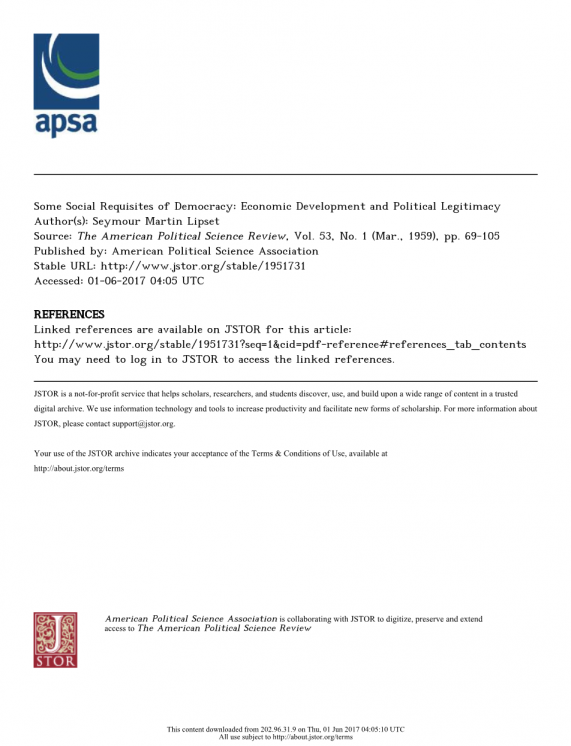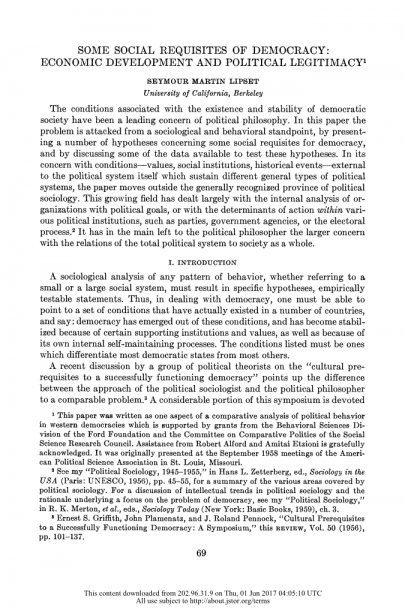II. ECONOMIC DEVELOPMENT AND DEMOCRACY
经济发展与民主
Perhaps the most widespread generalization linking political systems to other aspects of society has been that democracy is related to the state of economic development. Concretely, this means that the more well-to-do a nation, the greater the chances that it will sustain democracy. From Aristotle down to the present, men have argued that only in a wealthy society in which relatively few citizens lived in real poverty could a situation exist in which the mass of the population could intelligently participate in politics and could develop the self-restraint necessary to avoid succumbing to the appeals of irresponsible demagogues. A society divided between a large impoverished mass and a small favored elite would result either in oligarchy (dictatorial rule of the small upper stratum) or in tyranny (popularly based dictatorship). And these two political forms can be given modern labels: tyranny#39;s modern face is Communism or Peronism; oligarchy appears today in the form of traditionalist dictatorships such as we find in parts of Latin America, Thailand, Spain or Portugal.
也许,把政治制度与社会其他方面联系起来的最普遍的观点是,民主与经济的发展状况有关。具体地说,也就是一个国家越富裕,它维持民主的可能性就越大。从亚里士多德到现在,人们认为只有在一个公民相对较少的处于生活贫困状态的富裕社会中,大众才可能明智地参与政治, 避免屈服于不负责任的政治家。一个分为大量贫困群众和小惠精英的社会会产生寡头政治(即上层独裁统治)或专制暴政(通常为基础的独裁)。这两种政治形式可以被贴上现代的标签:专制暴政的现代面貌是共产主义或庇隆主义;寡头政治以传统独裁统治的形式出现,如在拉丁美洲、泰国、西班牙或葡萄牙等地区。
As a means of concretely testing this hypothesis, various indices of economic development wealth, industrialization, urbanization and education have been defined, and averages (means) have been computed for the countries which have been classified as more or less democratic in the Anglo-Saxon world and Europe and Latin America.
— —
作为具体检验这一假设的一种手段,各种经济发展指数如财富、工业化、城市化和教育等被定义,并计算了在盎格鲁-撒克逊世界和欧洲以及拉丁美洲中被划分多民主或少民主国家的平均数(平均数)。
In each case, the average wealth, degree of industrialization and urbanizashy; tion, and level of education is much higher for the more democratic countries, as the data presented in Table II indicate. If we had combined Latin America and Europe in one table, the differences would have been greater.U
在每一种情况下,多民主国家的平均财富、工业化和城市化程度以及受教育程度要高得多,如表二数据所示。如果我们把拉丁美洲和欧洲合并在一张表上,那么差别就更明显了。
表二 欧洲讲英语的国家和拉丁美洲国家通过财富、工业化、教育和城镇化区分“更民主”和“不民主”的对比分析
|
A.财富指数 |
||||||||
|
人均 |
成千上万 |
人 |
电话 |
无线电报 |
报纸 |
|||
|
含义 |
每千人 |
每人 |
收入 |
每1000 |
每1000 |
|||
|
每人医生 |
人员 |
人员 |
1,000人 |
|||||
|
欧洲讲英语的稳定的民主政体的国家 |
695 |
86 |
17 |
205 |
350 |
341 |
|
欧洲讲英语的不稳定的民主政体和独裁专制的国家 |
308 |
1.4 |
143 |
58 |
160 |
167 |
|
拉美民主政体和不稳定的专政的国家 |
171 |
2.1 |
99 |
25 |
85 |
102 |
|
拉丁美洲稳定专政的国家 范围 |
119 |
4.4 |
274 |
10 |
43 |
43 |
|
欧洲稳定的民主政体的国家 |
402-1453 |
7-1.2 |
3-62 |
43-400 |
160-995 |
242-570 |
|
欧洲专政的国家 |
128-482 |
6-4 |
10-538 |
7-196 |
42-307 |
46-390 |
|
拉美民主政体的国家 |
112-346 |
.8--3.3 |
31-174` |
12-58 |
38-148 |
51-233 |
|
拉丁美洲稳定专政的国家 |
40-331 |
1.0-10.8 |
38-428 |
1-24 |
4-154 |
4-111 |
B.工业指数
|
含义 |
在农业男性百分比 |
消费 |
|
欧洲稳定的民主政体的国家 |
21 |
3.6 |
|
欧洲专政的国家 |
41 |
1.4 |
|
拉美民主政体的国家 |
52 |
.6 |
|
拉丁美洲稳定专政的国家 |
67 |
.25 |
|
范围 |
||
|
欧洲稳定的民主政体的国家 |
6-46 |
1.4-7.8 |
|
欧洲专政的国家 |
16-60 |
.27-3.2 |
|
拉美独裁统治的国家 |
30-63 |
.30-0.9 |
|
拉美稳定专政的国家 |
46-87 |
.02-1.27 |
C.教育指标
lt;


英语原文共 38 页
|
含义 |
百分比 识字 |
小学教育 每月入学1000人 |
初等教育后 每月入学1000人 |
高等教育 每月入学1000人 |
|
欧洲稳定的民主国家 |
96 |
134 |
44 |
4.2 |
|
欧洲独裁的国家 |
85 |
121 |
22 |
3.5 |
|
拉美民主政体的国家 |
74 |
101 |
13 |
2.0 |
|
拉美独裁的国家 |
46 |
72 |
8 |
1.3 |
|
范围 |
||||
|
欧洲稳定的民主国家 |
95-100 |
96-179 |
19-83 |
1.7-17.83 |
|
欧洲独裁的国家 |
55-98 |
61-165 |
8-37 |
1.6-6.1 |
|
拉美民主政体的国家 |
48-87 |
75-137 |
7-27 |


